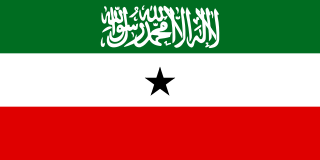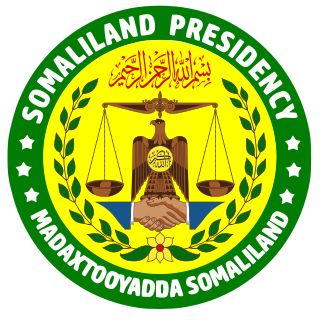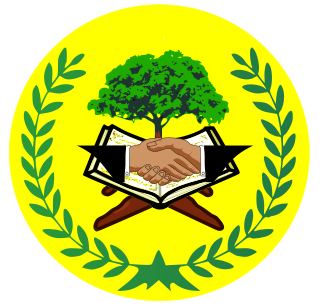
Somaliland, officially the Republic of Somaliland, is an unrecognised country in the Horn of Africa. It is located in the southern coast of the Gulf of Aden and bordered by Djibouti to the northwest, Ethiopia to the south and west, and Somalia to the east. Its claimed territory has an area of 176,120 square kilometres (68,000 sq mi), with approximately 6.2 million people as of 2024. The capital and largest city is Hargeisa.

The president of the Republic of Somaliland is the head of state and head of government of Somaliland. The president is also commander-in-chief of the Somaliland Armed Forces. The president represents the Government of Somaliland.

Dahir Riyale Kahin is a Somaliland politician who was President of Somaliland from 2002 to 2010. He previously served as a senior officer in the National Security Service in Somalia, and he was Vice President of Somaliland from 1997 to 2002

Greater Somalia sometimes also called Greater Somaliland is the geographic location comprising the regions in the Horn of Africa in which ethnic Somalis live and have historically inhabited.

Mohamed Haji Ibrahim Egal was a Somali politician who served as the president of Somaliland from 1993 to his death in 2002. He previously served as the prime minister of the State of Somaliland between 26 June and 1 July 1960 and as the first prime minister of the Somali Republic for eleven days in 1960 and again from 1967 to 1969.

The Isaaq is a major Somali clan. It is one of the largest Somali clan families in the Horn of Africa, with a large and densely populated traditional territory.

The Somali Republic was formed by the union of the Trust Territory of Somaliland and the State of Somaliland. A government was formed by Abdullahi Issa Mohamud and Muhammad Haji Ibrahim Egal and other members of the trusteeship and protectorate administrations, with Haji Bashir Ismail Yusuf as President of the Somali National Assembly and Aden Abdullah Osman Daar as President of the Somali Republic. On 22 July 1960, Daar appointed Abdirashid Ali Shermarke as prime minister. On 20 July 1961 and through a popular referendum, Somalia ratified a new constitution, which was first drafted in 1960. The new constitution was rejected by Somaliland.

Edna Adan Ismail is a nurse midwife, activist, and was the first female Foreign Minister of Somaliland from 2003 to 2006. She previously served as Somalia’s Minister of Family Welfare and Social Development.

The House of Elders, also known as the Guurti, is the upper house of the Parliament of Somaliland. It has 82 members, representing traditional leaders. The House of Elders is mandated with considering bills proposed by the lower house of the parliament, the Somaliland House of Representatives.

Somaliland, officially the State of Somaliland, was a short-lived independent country in the territory of the present-day unilaterally declared Republic of Somaliland, which regards itself as its legal successor. It existed on the territory of former British Somaliland for five days between 26 June 1960 and 1 July 1960, when it merged with the formerly Italian administered Trust Territory of Somaliland to form the Somali Republic.

The Somali Youth League, initially known as the Somali Youth Club (SYC), was the first political party in Somalia.

The Constitution of the Republic of Somaliland is the supreme source of national law of Somaliland, an unrecognised state considered to be part of Somalia by the international community, adopted by the Houses of the Parliament of Somaliland on 30 April 2000. The constitution was approved in a referendum held on May 31, 2001, when 97% of the voters voted in its favour. Its re-published version consists of a preamble (Arar) and five main chapters (Qaybo) each of which is subdivided into parts (Xubno). There is now a total of 130 articles (Qodobo) as compared to the previous 156 articles.

The following outline is provided as an overview and topical guide to Somaliland:

Independence Day is a national holiday observed annually in Somalia on July 1. The date celebrates the unification of the Trust Territory of Somaliland and the State of Somaliland into the Somali Republic on July 1, 1960. A government was subsequently formed by Abdullahi Issa, Muhammad Haji Ibrahim Egal, and other members of the trusteeship and protectorate governments with Aden Abdullah Osman Daar as president. On July 20, 1961, through a popular referendum, the people of Somalia ratified a new constitution.

Musa Bihi Abdi is a Somaliland politician and former military officer who served as the 5th President of Somaliland from 2017 to 2024.
The following lists events that happened during 1960 in Somalia.

Ahmed Mohamed Adan was the foreign minister of Somalia from 1990 until 1991. He was Somalia's Ambassador to the United States, Soviet Union, Britain, and the United Nations. He was the speaker of House of Representatives of Somaliland from 1997 to 2005.

The Somaliland Declaration of Independence was made on 18 May 1991 by Somali sultans from the Isaaq, Dhulbahante, Issa, Gadabursi, Warsangali clans, as well as the Somali National Movement.

The Government of the Republic of Somaliland (JSL) is the central government of Somaliland. The Government of Somaliland consists of legislative, executive, and judicial branches, each of which functions independently from the others. The Government runs under the framework established by the Constitution of Somaliland, adopted in 2001. It is a unitary state. The seat of the government is located in Hargeisa, the capital of Somaliland.

Presidential elections were held in Somaliland on 23 February 1997, the third indirect presidential election since the country declared its independence from Somalia in 1991. The elections took place towards the end of the Hargeisa Conference, held between October 1996 and February 1997. The election resulted in incumbent President Muhammad Haji Ibrahim Egal being reelected to a four-year term by an electoral college of elders who made up the national guurti(council of elders). Egal's closest competitor was Minister of Finance Suleiman Mohamoud Adan, who was also formerly in the cabinet of inaugural President Abdirahman Ahmed Ali Tuur.

















